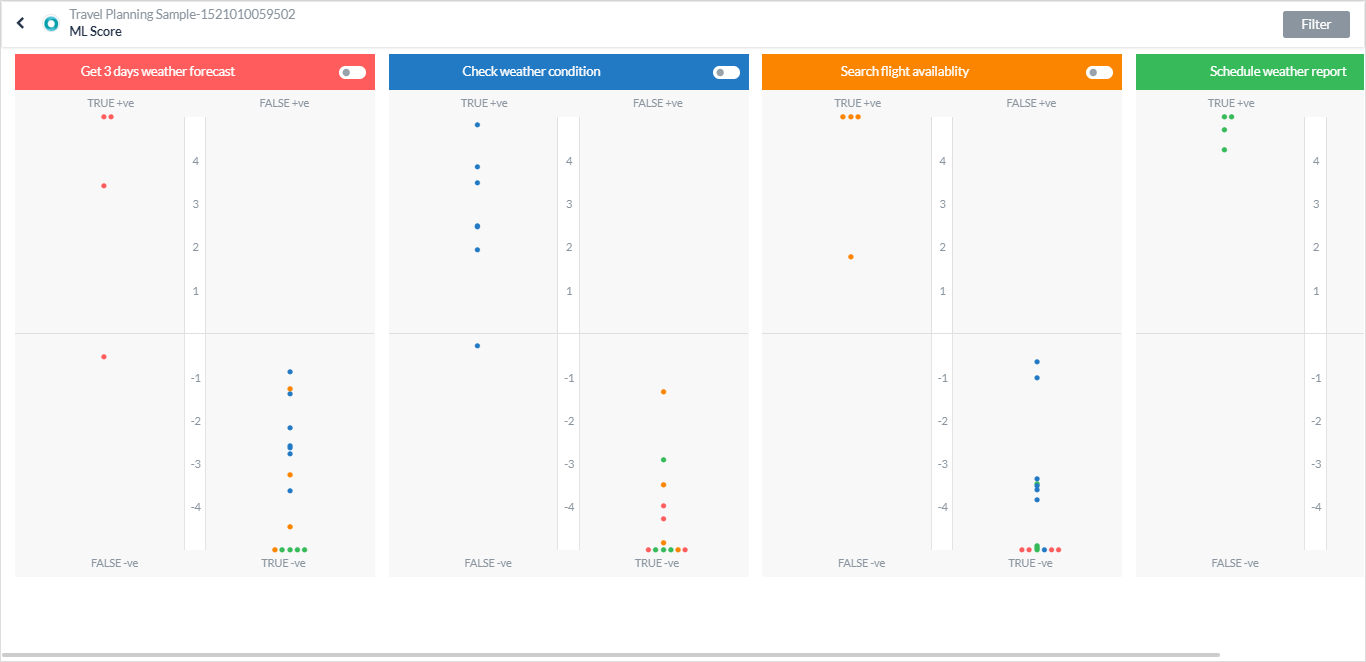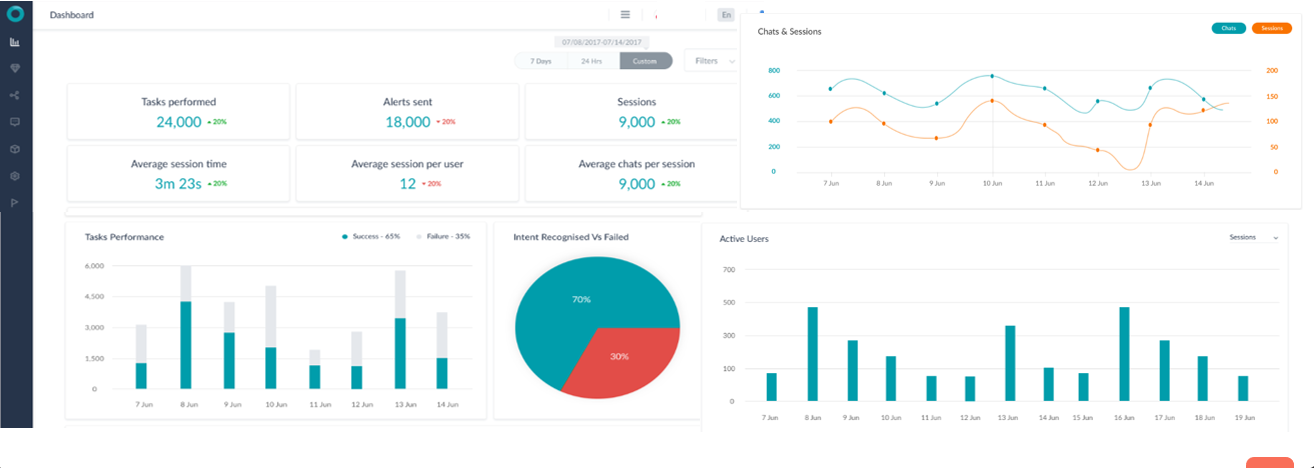Conversational AI is making rapid forays into the enterprise sector. As bots proliferate and impact many enterprise functions, the focus has shifted to leveraging these applications with the right kind of capabilities.
Bots have been there for a while now. A bot can be created with a set of conversational tools, dialog management methods and artificial intelligence capabilities. There are also tools and frameworks out there to build bots. But enterprises need more than that as they have unique requirements and responsibilities.
The must-have components in an enterprise bot-building platform include: end-to-end bot life cycle management tools, NLP and training models, task execution framework, dialog intelligence, test and debug options, omni-channel capabilities, administration, management & analytics, continuous training (post go-live), security, compliance & scalability, and platform openness.
Why you need an end-to-end platform
Enterprises need a robust platform to not only create and train bots, but also to test, publish, and manage the bots throughout their life cycle, including versioning and upgrading. The platform must have the ability to orchestrate messages — a middleware for storing, formatting and transforming content. Having pre-built integrations with communication channels and enterprise systems saves huge costs and valuable time. The platform must also support on-premise and cloud deployment models. Multilingual capability is a preferred feature for global enterprises. The platform must provide the ability to design bots for use by the workforce and for the general public.
Also Read: Kora Represents the Pinnacle of Contemporary UX You Can Easily Access |
NLP and Training
A bot can be considered successful only if it can mimic human behavior efficiently and partner with humans to complete tasks productively. For a bot to converse with humans successfully, the bot must have natural language processing (NLP) capabilities. You can consider this to be the brain of the bot — understanding natural language, analyzing user utterances, identifying intents, extracting entities and performing tasks. Additionally, bots must be able to learn from interactions, just like humans. Here is where machine learning techniques come into play — the use of synonyms, patterns and ontologies to enrich the bot’s ability to correctly identify user intents. For FAQ tasks, the platform must provide knowledge graph models.

Task execution framework
Bots are employed to get tasks done. Tasks can be of various types such as, sending alerts and notifications based on user-defined events, answering questions from knowledge bases, fetching reports, updating systems of record and performing complex tasks involving complex logic and multiple systems. You can design smart alerts that not only send notifications, but also provide next step actions. The bot-building platform must provide the ability to design such tasks and have the framework to interconnect with enterprise interfaces for data exchange.
Dialog intelligence
Having intelligent conversations is the key to success. For this to happen, the bot must accommodate all the nuances and patterns in human communications. Some of the key elements are: context handling, sub-intent and multiple intent handling, sentiment analysis etc.
Context handling
Bots must be context-aware and must retain memory, both short-term and long-term. In an enterprise context, the bots must be able to recognize the users based on their profile and remember current and prior conversations. Context must be maintained across various levels — sessions, users, bots and enterprise levels.
Pause and resume
Bots must have the ability to start and stop tasks based on users’ intent. If users change their mind in the middle of a task and decide to complete another task before resuming the original task, the bot must be able to accommodate such scenarios.
Sub-intent handling
There are occasions when the bot needs be able to analyze an intent within an intent (a sub-intent) and satisfy both tasks in the same conversation.
Multiple intents
Bots must have the capability to perform multiple tasks — processing multiple interrelated intents and completing sequential tasks within the same conversation.
Sentiment analysis
Emotions are at the base of human conversations. Bots must be able to recognize the user’s state of mind and respond accordingly. The platform must have the ability to score emotions based on human utterances and when threshold values are breached, the bot must know when to transfer the conversation to a human agent. Agent transfer capability can also be designed within the dialog builder by creating conditional nodes for branching out to agents based on certain user utterances.
Elaborations, syncs, interruptions, pauses
Many times, conversations involve clarifications, interruptions, pauses etc. The bot is trained to accommodate such human conversational nuances and respond appropriately and naturally.
Also Read: How Kora Helps You Tide Over COVID-19 Crisis |
Test and debug capabilities
Bots must be tested thoroughly before publishing them to end-users. Testing includes the platform’s ability to analyze user utterances that successfully resulted in task completion and separating the utterances that failed to recognize intents or resulted in incomplete tasks. Tasks could also fail due to broken connections and systemic defects. Machine learning techniques can be used to make sure that the bot is trained with a large vocabulary of human nuances and by integrating a language corpus.
Machine learning model analysis
A machine learning model identifies the utterances that successfully resulted in task completion and separates the utterances that failed, thus identifying the utterances that need further training.

Omni-channel capabilities
Channels are where the conversations happen. Popular channels include messengers (enterprise and social), voice assistants (Alexa, Google Home etc.), IVR, Email, SMS, Web etc. The platform must be able to add channels with minimum setup time and must provide the ability to move conversations from one channel to another while retaining the history of the conversation. Automatic message formatting and built-in authorization control are desired features.
Management and analytics
Enterprises need centralized control over all the bots deployed in their organizations, the users that are engaging the bots, the type of tasks that are being performed, the channels where the bots are living etc. The platform must provide the ability to enroll users (including bulk enrollment and directory sync), assign users to bots, manage permissions, and maintain versions etc. All the above activities and events must be visually represented in dashboards and downloadable reports.

Continuous training (post go-live)
Once the bot is live and made generally available to the enterprise users, the scope of bot usage expands, with users trying out various ways to get tasks done by the bot. This real-world usage provides ample opportunities to improve the natural language understanding capabilities of the bot.
Failure management — The platform must provide the capability to capture failed scenarios and provide the tools for bot administrators to perform failure analysis and take corrective actions.
Re-training — The platform must provide the scope to re-train the bot with new utterances gathered from real-world usage, external sources, and expand the performance of the bot.
Security and compliance
Security is of paramount consideration for enterprises and this includes the security of the conversations, content and the transactions the bots have with users. The bot-building platform must be compliant with information security standards such as GDPR, HIPPA, SOC 2 etc. Robust security practices must include encryption across all sections, including authentication and authorization mechanisms. Audit logs must be maintained for all system interactions across various levels. Once secure, the platform can scale up users and conversations.
Open and extensible platform
Enterprises sometimes need to toggle between various components based on specific business requirements. For example, some companies would like to explore external NLP engines and other components such as speech engines, analytics engines, image processing engines etc. The platform must be able to accommodate such needs by providing the ability to plug-in or unplug components with ease. The platform must be able to provide the means to move data around using bot-kits and associated components making the platform extensible. The platform must also have the advantage of pre-built integrations with enterprise systems.
Also Read: 3 Best Tips to Localize Your Chatbot |
Other Specialized Features
Smart Bots: Bots can be designed to perform specialized functions such as customer service, IT support, HR, Finance, Sales etc.
Universal Bots: Enterprises can also design universal bots that orchestrate tasks from multiple specialized bots.
Importing and exporting bots: Bots can be imported and exported to enable users to clone new bots or extend the bot’s features. The source bot’s definitions, components and configurations are also migrated and inherited by the target bot.
At Kore.ai, we have engineered the industry’s most comprehensive and sophisticated, yet simple and intuitive platform to create, train and manage your own bots. Our end-to-end platform helps design, build, test, and manage the entire life cycle of AI-rich bots for use across 24 channels as well as out-of-the-box solution bots for critical systems, functions and industries. Together, the platform and Smart Bots bots equip industry leaders with everything needed to get to market and realize ROI faster.
Access the complete CIO Toolkit for valuable resources to help you define develop, and execute a chatbot strategy. Get the CIO Toolkit below.











